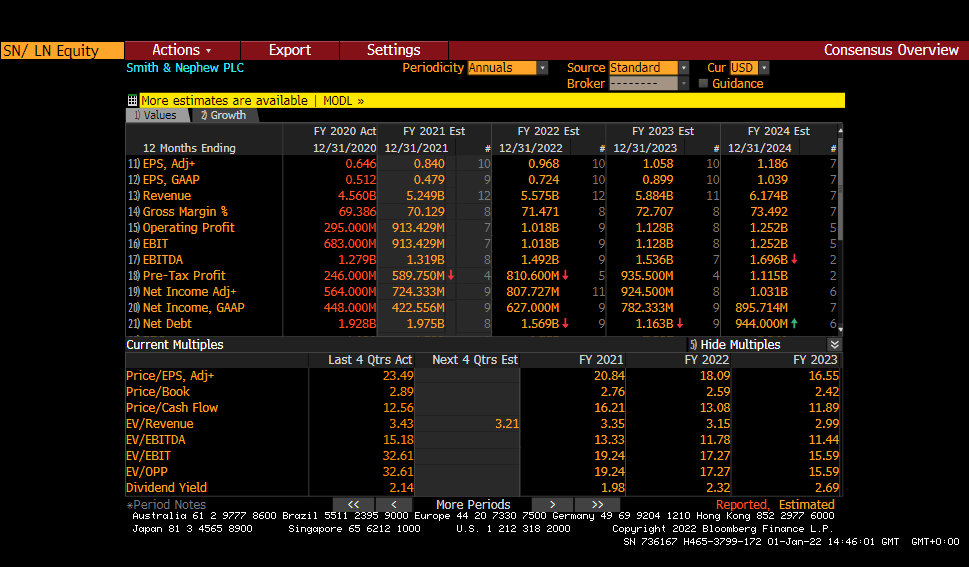In 1856 a Mr. Thomas James Smith opened a pharmacy in Hull. He ran this business until his passing in 1896, at which point his nephew Horatio Nelson Smith took over the running of the business. Thus, Smith + Nephew was born.
The shares were first listed in London in 1937 (it has paid a dividend in every year since then), adding an NYSE listing in 1999. In 2001 SN/ joined the FTSE 100.
Between 2007 and 2020 SN/ delivered CAGR of 3.2% in EPS (this is depressed by 2020 being a year in which COVID weighed on earnings); CAGR of 9.2% in DPS (which better reflects normalised performance) and CAGR of 9.0% in NAV, while the average annual fully diluted share count contracted at a CAGR of 0.4% over that period.
The Group has three core franchises – Advanced Wound Management; Sports Medicine & ENT; and Orthopaedics. Its market share across its business units ranges between 7% and 26%. Major competitors include Zimmer, Stryker, DePuy and 3M. SN/ operates globally, with manufacturing facilities located in the US, UK, Costa Rica, Germany, Switzerland, Canada, India and China.
COVID-19 has disrupted elective surgery around the globe. In 2020 its addressable markets contracted by between 3% (Advanced Wound Management) and 15% (Hip and Knee Implants). As the world has learned to (at a minimum) live with COVID-19, it seems rational to assume that normalised growth will return to at least (see below) the 2-5% CAGR recorded across 2017-19 due to a combination of ageing populations and rising prosperity.
On 16 December the Group unveiled its ‘Strategy for Growth’. The targets unveiled at this included: (i) consistent 4-6% organic revenue growth by 2024, which seems undemanding given the track record cited above, rising prosperity, and global demographics (ageing populations underpinning rising need of joint replacements etc.); (ii) rebuilding trading margin to at least 21% by 2024 with further improvements thereafter; (iii) maintaining higher investment in innovation to drive organic growth; (iv) continue acquiring new technologies and expanding in higher growth segments; (v) maintaining progressive dividend policy and investment grade credit metrics; and (vi) a new commitment to return surplus capital through a regular annual share buyback, with $250-300m guided for 2022.
As mentioned above, COVID-19 has disrupted activity. In Q1 2021 the Group reported underlying growth of 6.2%. In Q2 2021, underlying growth (swollen by easy comparatives) jumped to 40.3%. In Q3 2021 underlying growth was 2.3%. Unsurprisingly, there is significant operating leveraging in this business. Operating margins in FY 2019 (pre-COVID) were 15.9% on revenue of $5.1bn while in FY 2020 they slumped to 6.5% on revenue of $4.6bn. The uplift in revenue signalled by management over the first 9 months of 2021 should see a step-change in profitability.
The Group also has a strong balance sheet. Net debt (including pension liabilities) was $1.9bn at end-FY19 or 1.4x that year’s EBITDA. At end-FY20 net debt (on the same basis) was $2.1bn or 2.4x FY20 EBITDA (which was depressed due to COVID-19. For FY21 (i.e. the year just gone), Bloomberg consensus is for net debt of $2.0bn or 1.5x consensus EBITDA of $1.3bn. Net debt / EBITDA will mechanically decline (all else being equal) as earnings rebuild.

As mentioned above, on 16 December the Group held an investor day. At it, management set out how the Group is “at an inflection point” where it is “transforming to a structurally higher growth company and innovation is truly at the heart of it all”. As mentioned above, demographic reality and rising global prosperity underpin the demand for its core product offering, while its international market shares (it ships to 100 countries) leave it perfectly positioned to capitalise on these structural trends.
Management is working to improve efficiency, for example having its production facilities shipping directly to three global distribution centres which will, in turn, ship directly to customers wherever possible, simplifying the route from factory to customer and delivering working capital benefits. Another efficiency will come from simplifying the portfolio, trimming multiple product lines that serve the same clinical need.
The Group is also focused on innovation, having upped spend on R&D as a share of sales from 4.7% in 2017 to c.6% expected for FY 2021, which should underpin the faster growth in revenues guided for the medium term.
Lastly, SN/ is also maintaining an appetite for M&A to help “enhance our portfolio and pipeline”.
The near-term financial outlook for SN/ is clearly hard to predict given the disruption of COVID-19 and (not unrelated) global supply chain and inflation issues. Long-term, however, Smith + Nephew offers attractive global market shares in segments of the healthcare market that offer structural growth potential.
For me, I see a SN/ with sustainable 4-6% organic topline growth as being able to deliver 10%+ EPS CAGR due to: (i) operating leverage; (ii) the resultant lower share count from buybacks; (iii) the benefits from efficiency and R&D programmes cited above; and (iv) M&A. For an industry leader to be trading on 11.8x 2022 EV/EBITDA, a modest discount to the 12.0x that the FTSE All-Share Health Care Index is on, seems anomalous, in my view. For these reasons, I am happy to be long Smith + Nephew.
If you’d like to be notified of future blogs, why not subscribe using the box below?